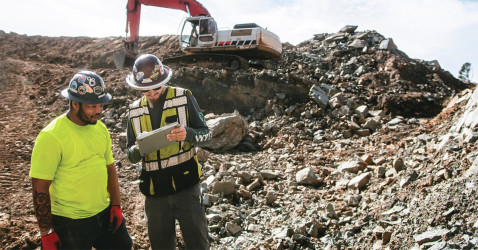Mastering construction project management with 6 key strategies

Effective construction project management requires you to balance multiple moving parts. A rapidly changing landscape means employing numerous strategies to get the job done to your client’s satisfaction. What should you know to maximize your profits and grow your business?
Today’s tools can make it easier than ever if you take your time to learn how to use them correctly. Acquisition alone doesn’t do the trick — it’s integrating them into your daily practices and training your team on best use and improved methods. Here’s how you can master project management in 2024 with six key strategies.
1. Embracing technology in the construction project life cycle
In order to use today’s technology to improve your project management strategies, you must understand how it can assist you through each stage of the construction life cycle. Each project goes through five distinct phases, and modern tools can facilitate the process:
- Planning and design: Identify issues before they occur and stay in compliance with codes.
- Preconstruction and procurement: Negotiate and sign contracts with subcontractors.
- Execution: Monitor worksite conditions and ensure quality control.
- Operations and management: Train building occupants in proper use.
- Closing: Ensure deliverables meet client expectations and sign requisite documents.
For example, the right building software alerts you instantly when a wall lacks sufficient outlets, saving considerable time, labor and energy. Additionally, experts predict commercial drone use on construction sites will exceed consumer use, as these devices allow management to oversee far more than they could from the ground. They can quickly identify issues in real time.
Learning how to use new technological tools takes time, and insisting your staff use them without proper training spurs resentment and lack of buy-in. However, managers often balk at losing what they see as productive time to training.
One solution is to seek easy-to-use software that doesn’t require extensive skills to master — some apps take only a few hours to a single day to learn. Teams are often more open to simple solutions and retain new information better in smaller chunks. Your vendor can give a good idea of how long training will last, so determine this and set up an abbreviated training schedule at the point of purchase.
2. Setting project goals and developing a plan
As a business leader, you know the famous quote that goes something like, “Failure to plan is equivalent to planning to fail.” However, it’s easy to lose sight of the fact that you need a blueprint for each project you create and communicate that mission to all stakeholders.
For example, how well do each of your subcontractors understand the overall project vision if they aren’t sitting in meetings with crucial decision-makers? If you, as the general contractor, are the main point of contact between the organization requesting the build and those doing the labor, you take on the role of communications director. You must apprise crews of changing client needs and ensure they have adequate time and resources to complete the work as specified.
Here’s another arena where the right software serves as a key project management strategy. The right tools help you create rapid estimates for change orders and keep all parties informed of when they can expect delivery.
3. Effective team management
Your team is the lifeblood of your organization, but far too many business owners have begun to regard labor as little more than a liability on their balance sheet. Your first job is to improve this mindset — you are a team. The whole idea of business is that people working together can achieve more than anyone alone, but that implies that each individual member can meet their needs.
Do your hourly wages and benefits afford a decent standard of living? Many companies desire availability, which means your full-time staff shouldn’t need multiple side hustles to survive. How open is your door to employees experiencing difficulties? Is your attitude, “what happens outside of work doesn’t matter here,” or does your team feel safe expressing concerns that impact their productivity? Do you offer counseling, financial or otherwise, for those struggling?
Finally, you need a conflict resolution system for handling disputes between team members. While many in the construction industry take a hands-off approach, you should know when to intervene to avoid creating a toxic environment that affects productivity and morale. For example, intervene when:
- “Friendly banter” becomes bullying: Take the parties aside separately and privately to gauge how each person feels.
- Language becomes threatening, explicit or aggressive: You should never tolerate verbal abuse in the workplace.
- A teasing conversation becomes insulting or disrespectful: Light teasing can make the workplace more enjoyable and friendly, but it should never cross the line to disrespectful.
- Conflicts affect productivity or impact morale: If team members refuse to work with one another or don’t work well together because of a conflict, you should intervene.
4. Risk management
You must keep your crews safe. For example, falls, scaffolding and ladders are frequent causes of OSHA violations and can lead to permanent injuries that affect a worker’s entire career. Additionally, following proper tagout procedures is crucial to avoiding electrocution. Investing in risk management technology nearly always makes financial sense for construction crew leaders. For example, your average mid-level camera drone costs between $500 and $1,000. Compare that to the price of a typical worker’s compensation claim at $41,747. While your coverage will absorb much of the cost, a single craft costs less than the average annual premium.
5. Stakeholder management
The toughest part of project management may be keeping everyone on the same page. Many business owners think of this project management step as tending to the client, but it goes further. You must also communicate with subcontractors, staying on top of progress reports and handling delay-causing snafus. It also includes people you might not expect. For example, many crews renovate existing, occupied buildings. Teams that go beyond to minimize dust, noise and frustration will get noticed — and hired for future work. Don’t overlook the importance of treating everyone with respect and consideration, even if you don’t typically communicate with them on project progress.
6. Monitoring, control and continual improvement
When you finish a construction project, do you and your team debrief and reflect or is it on to the next? While you must keep up production to cover expenses, you shouldn’t miss valuable opportunities to learn and grow, honing your project management strategies to improve future profitability. Provide a feedback form that allows all team members to describe what went well and what they think needs improvement. Evaluate these responses and call a meeting to hash out new processes. Team members are more likely to follow the guidelines they help create, especially when they see the link between their feedback and continuous process improvements.
Key project management strategies
Mastering project management requires you to employ the most effective strategies for the modern world. Today’s technologies make various aspects of the construction process easier when everyone understands their use. Level up your game in 2024 with these key project management strategies for your construction team. Feel more effective and organized while exceeding client expectations and building a team that makes you enjoy going to work each day.

 Rose Morrison •
Rose Morrison • 




















